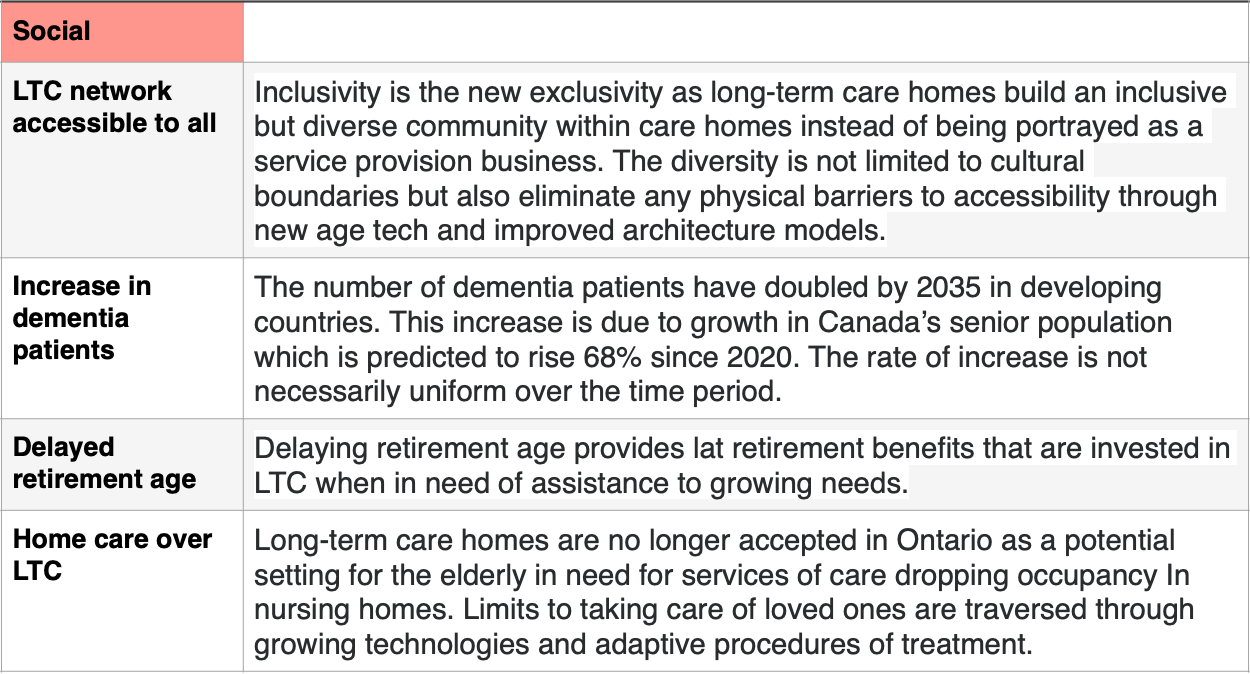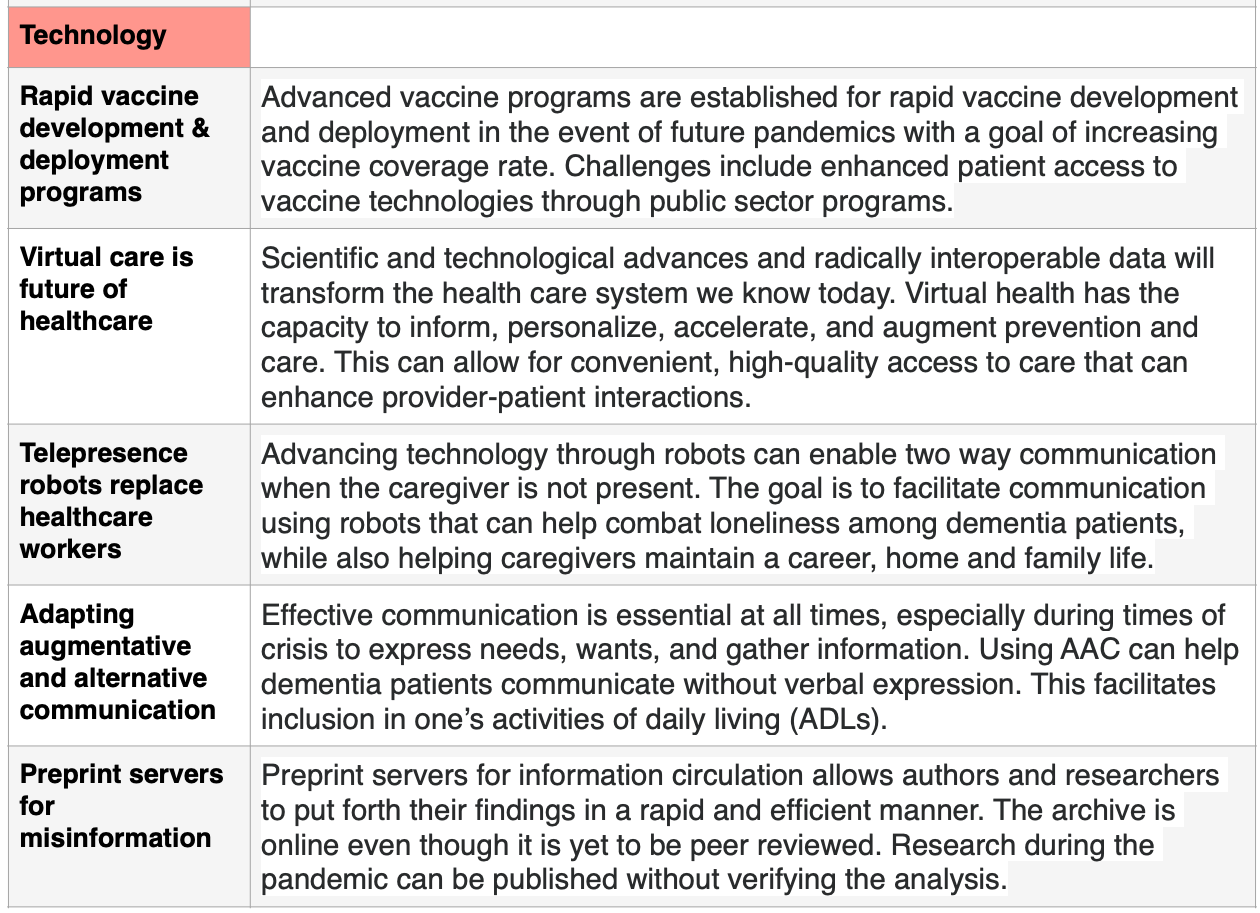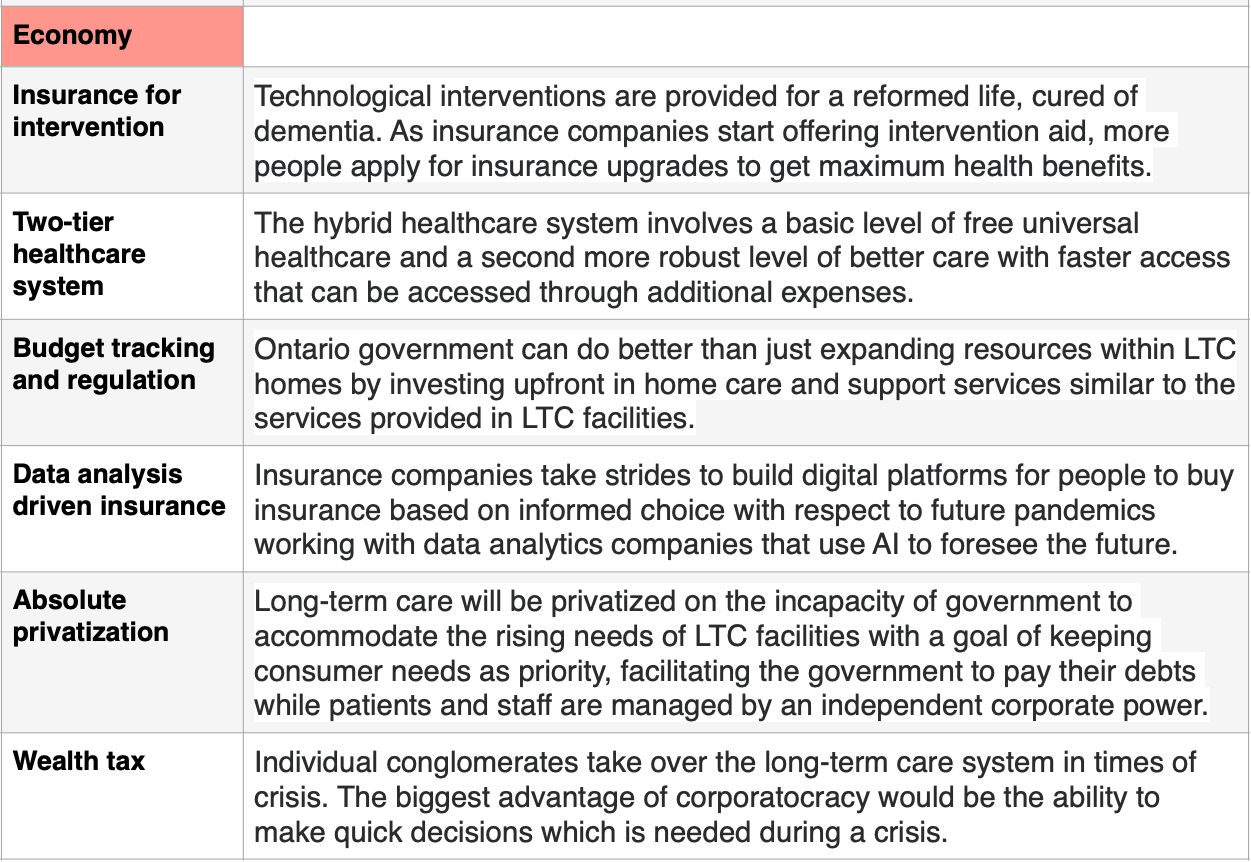Framed during the COVID-19 pandemic, this final year project highlights challenges faced by dementia patients in the long-term care system in Ontario during the pandemic. The field of study is explored using foresight methods to better understand future care provisions in the event of impending pandemics. The project aims to develop alternative future potential scenarios for dementia care.
Design Methods
Secondary research, Environmental scanning, Trend matrix, Generic futures, Scenario building, Backcasting, Stakeholder mapping
The introduction of the COVID-19 pandemic has exposed deep flaws with the long-term care system that makes it vulnerable in a disruptive event. Residents in care had to undergo limited contact for 'secure isolation', given the high mortality rates from the pathogen. But this change had marked severe depression without the support of loved ones, progressing their mental and behavioural health disorders.
Research Question
In a world that is becoming significantly transnational, progressing rapidly on scientific and technological frontiers, this research aims to understand and identify potential ways to build on long-term care in the event of a future global pandemic. The research question is framed as:
What does the future look like for dementia patients in long-term care homes of Ontario, in the context of impending pandemics?
Methodologies
This project implements foresight methods to make sense of research, envision possible alternatives of the future and provide interventions to foreseeable events in the future.
A preliminary review has been conducted by surveying latest articles, medical journals and reliable statistics as well as attending webinars and podcasts. This data has particularly been important in contributing to other design methods as well as setting a need for the project.
Literature Review
Articles, medical journals and statistical data were analyzed sourcing from the web while podcasts and webinars informed on the current developments in the LTC system during the pandemic. This literature later contributed information for the foresight methods used in this project.
Articles, medical journals and statistical data were analyzed sourcing from the web while podcasts and webinars informed on the current developments in the LTC system during the pandemic. This literature later contributed information for the foresight methods used in this project.
Environmental Scanning
Trends in the long-term care environment were gathered by scanning current events from news, magazines, blogs and journals to find influential changes that can anticipate future. Using STEEPC allowed for an extended search covering the subject matter holistically. These trends were sorted into the trend matrix and generic future respectively to narrow down the research question for suitable strategies.
Trends in the long-term care environment were gathered by scanning current events from news, magazines, blogs and journals to find influential changes that can anticipate future. Using STEEPC allowed for an extended search covering the subject matter holistically. These trends were sorted into the trend matrix and generic future respectively to narrow down the research question for suitable strategies.



Stakeholder Map
The map identifies primary users within the long-term care system who have had to deal with the pandemic from the frontline. It is divided on the basis of receiving, providing and regulating care. The map helps in identifying the target audience for providing intervention.
The map identifies primary users within the long-term care system who have had to deal with the pandemic from the frontline. It is divided on the basis of receiving, providing and regulating care. The map helps in identifying the target audience for providing intervention.
Trend Matrix
The large amount of gathered information was summarized on high-level using the trend matrix method across time on aspects that have drastically changed during the pandemic.
The large amount of gathered information was summarized on high-level using the trend matrix method across time on aspects that have drastically changed during the pandemic.
Generic Futures
In order to create distinct visions of the future of long-term care, narrative scenarios were drawn on the four futures of growth, collapse, discipline and transform.
In order to create distinct visions of the future of long-term care, narrative scenarios were drawn on the four futures of growth, collapse, discipline and transform.
Insights
from Trend Matrix
The significant impact of emerging technology on other macro-trends was recognized. The rapid rate at which technology is growing leads the world into an era of digital transformation. The capacity to embed technology and the internet into literally anything and everything is a growing trend. Applying the same within the LTC system, there is renewed interest in innovative technologies to improve care for the elderly. Technology can communicate and receive input from dementia patients for research and development purposes to better provide for their needs.
The significant impact of emerging technology on other macro-trends was recognized. The rapid rate at which technology is growing leads the world into an era of digital transformation. The capacity to embed technology and the internet into literally anything and everything is a growing trend. Applying the same within the LTC system, there is renewed interest in innovative technologies to improve care for the elderly. Technology can communicate and receive input from dementia patients for research and development purposes to better provide for their needs.
from Generic Futures
Of the four, the Growth scenario has been selected as it is most feasible to transpire by the year 2035. In this future, long-term care homes have expanded their services to in-home care to provide care at home itself. A major opportunity is to recognize the importance of home care instead of displacing the elderly from their homes. This creates a positive impact on dementia patients, including their needs as well as their care givers'. There is considerable potential to work upon and expand towards the Growth Future keeping in view the major shifts already happening in the immediate environment of LTC due to COVID-19.
Social aspects, policies reshape to adjust to this new way of life wherein the elderly decide on their need for services. Businesses find new opportunities in this growth future by expanding their product line to make in-home care feasible. This eventually creates an independent environment for both dementia patients as well as their caregivers.
Of the four, the Growth scenario has been selected as it is most feasible to transpire by the year 2035. In this future, long-term care homes have expanded their services to in-home care to provide care at home itself. A major opportunity is to recognize the importance of home care instead of displacing the elderly from their homes. This creates a positive impact on dementia patients, including their needs as well as their care givers'. There is considerable potential to work upon and expand towards the Growth Future keeping in view the major shifts already happening in the immediate environment of LTC due to COVID-19.
Social aspects, policies reshape to adjust to this new way of life wherein the elderly decide on their need for services. Businesses find new opportunities in this growth future by expanding their product line to make in-home care feasible. This eventually creates an independent environment for both dementia patients as well as their caregivers.
Proposals
The proposals provide a starting base for the project to develop further. Keeping in mind the rate at which technology is making giant leaps and adapting into our everyday lives, interventions have been provided on the same. They are intended for patients, immediate caregivers as well as the long-term care system.
Patients
Sensory Technologies: As sensory technology transcends new boundaries, it will enable dementia patients to explore unique sensory experiences including vision, hearing, smell and touch. This enhancement can refocus on supporting social interaction and communication during a pandemic.
Building a sensory-enhanced environment using IoT creates an efficient environment for interconnectedness that allows safety and security over the well-being of a dementia patient.
Sensory Technologies: As sensory technology transcends new boundaries, it will enable dementia patients to explore unique sensory experiences including vision, hearing, smell and touch. This enhancement can refocus on supporting social interaction and communication during a pandemic.
Building a sensory-enhanced environment using IoT creates an efficient environment for interconnectedness that allows safety and security over the well-being of a dementia patient.
Caregiver
Assistive technologies: Augmentative and alternative technologies can be effective to communicate with dementia individuals who face significant communication challenges. Digital AAC technologies can be enhanced, creating favourable circumstances for communicating with dementia patients.
In an effort to tend to people who are digitally averse, Artificial Intelligence of Things provides solutions. An efficient communication channel can be built by training caregivers in these technologies.
Assistive technologies: Augmentative and alternative technologies can be effective to communicate with dementia individuals who face significant communication challenges. Digital AAC technologies can be enhanced, creating favourable circumstances for communicating with dementia patients.
In an effort to tend to people who are digitally averse, Artificial Intelligence of Things provides solutions. An efficient communication channel can be built by training caregivers in these technologies.
Long term care System
The interplay between patients, caregivers, experts physicians, LTC shareholders, technologies etc. becomes more complex and erratic in the time of crisis. Technology aids smooth functioning of the various communication processes in a LTC home, developing a core hub that integrates all technologies, migrating manual processes to automated solutions without further human input.
Irrespective of the scale of facility, data can be collected, interpreted and analyzed even through remote monitoring. Any information that concentrates in the hub must be safeguarded by effective data management strategies.
The interplay between patients, caregivers, experts physicians, LTC shareholders, technologies etc. becomes more complex and erratic in the time of crisis. Technology aids smooth functioning of the various communication processes in a LTC home, developing a core hub that integrates all technologies, migrating manual processes to automated solutions without further human input.
Irrespective of the scale of facility, data can be collected, interpreted and analyzed even through remote monitoring. Any information that concentrates in the hub must be safeguarded by effective data management strategies.
Conclusion
Dementia is a substantial health concern with extensive research built over time on how competent care can be provided. The COVID-19 pandemic has forced people to be socially isolated, making them heavily dependent on technologies, not just for their entertainment but also for healthcare and safety reasons. Considering the current social and economic scenarios, this research paper touches upon recent technological innovations to foster and improve healthcare methodologies. A significant need for change at all levels of governance is recognized as a key factor to address the challenges in long-term care homes during a pandemic.
Alternative futures developed for this project serve as scaffolding to help individuals to construct a model of the LTC system and how it could evolve since the pandemic is a highly dynamic and radical phenomenon that challenges foresight studies.

